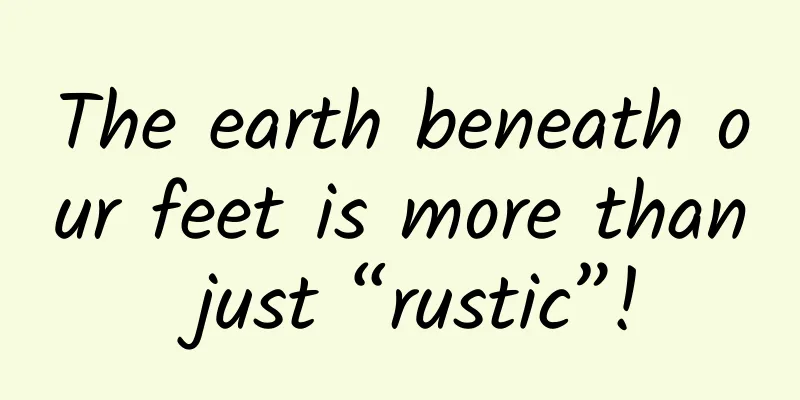The earth beneath our feet is more than just “rustic”!

|
If we were to transform into an ant-sized creature and dive into the "soil", what would we see? Wow, the substance that comes into view is not a ball of mud, but a soil layer with different color layers. It is composed of many particles of different sizes, including sand, powder, and clay. These particles are bonded together by the soil's high molecular organic matter or the "glue" decomposed by microorganisms to form large and small aggregates. There are many small gaps between the large and small aggregates, which are the "streets" and "houses" of the organisms in the soil. Walking on the "streets", we will also encounter various creatures. First come the microorganisms - bacteria, fungi and actinomycetes. They are the decomposers in the soil food web. There are various kinds of nematodes and larger insects such as earthworms, ants, beetles, etc. that live here. Soil is the home of organisms. The number of organisms in the soil is beyond people's imagination. Studies have shown that there are more organisms in a tablespoon of soil than the human population on Earth. Some organisms also deserve special mention, such as earthworms, which are the grandfathers of the soil society. They like to walk around to help aerate the soil, promote the mixing and decomposition of organic matter and soil, and make the soil more fertile. The feces of earthworms is also a high-quality fertilizer, so they are called "soil ecological engineers." There are a lot of pipes in the soil that can transport water and nutrients dissolved in water to the roots of plants. This is like the pipe system in a city, which delivers clean water and other resources to every household. Soil nurtures plants and eventually produces abundant fruits, directly or indirectly providing 95% of the food resources on the earth for humans and animals. Whether these foods are delicious and nutritious is closely related to the health of the soil. A healthy soil is rich in minerals, while a poor soil is lacking. The fruits and vegetables grown in the two types of land may look the same, but the taste and nutritional content may be very different. When we consume food grown in different soils, it will affect the growth, development and changes of certain organs in our body. Studies have found that food grown in fertile soil can not only reduce tooth decay, but also promote organ health. At the same time, the microorganisms in the soil help enhance immunity. Scientists have also found that children who grow up in rural areas with soil have fewer allergies than urban children, because the richer microbial flora in rural soil can provide more natural training for the immune system. Soil is also a big medicine box for humans. Antibiotics, which can inhibit the growth of bacteria or kill bacteria, have a deep relationship with it. Soil contains various fungi and actinomycetes, many of which can secrete secondary metabolites that have the ability to kill pathogenic microorganisms. Many of these substances with bactericidal effects have been screened and developed by scientists and have become antibiotics used in our medicine. These antibiotics can kill and inhibit pathogenic bacteria that invade the human body, effectively control the infection, and ultimately enable the body to heal and restore health. It can be seen that this rustic thing is a treasure of mankind. Unfortunately, as human society develops and progresses, soils are becoming less "earthy". Soil health faces threats such as erosion, pollution, salinization and acidification. Deforestation, overgrazing, industrial pollution, urbanization, and excessive use of fertilizers and pesticides are destroying the ecological balance of the soil. Only by deepening our knowledge of soil and understanding its "smell" can we better protect the soil and allow soil, one of the three elements of life that is as important as air and water, to bring sustainable health to people. Our goal is to ensure that the city develops and modernizes as it should, and that the land remains natural and purified as it should be. If one day we hear: This crop field is made of real soil, really good soil! This must be the best compliment to the land. This article is a work supported by the Science Popularization China Creation Cultivation Program Author: Dongdongmiao Popular Science Reviewer: Chen Nengchang, researcher at the Institute of Ecology, Environment and Soil Sciences, Guangdong Academy of Sciences, and director of the Science Popularization Committee of the Chinese Society of Soil Science Produced by: China Association for Science and Technology Department of Science Popularization Producer: China Science and Technology Press Co., Ltd., Beijing Zhongke Xinghe Culture Media Co., Ltd. |
Recommend
What designs in restaurants that you think are normal are actually draining your wallet?
Planning and production Source: Dr. Curious Edito...
The mortality rate is extremely high! This bacteria can "eat meat", so be careful in summer!
Produced by: Science Popularization China Author:...
How to increase App users by not filling in invitation codes
What should we do when fission marketing becomes ...
China Automobile Dealers Association: China Automobile Retention Value Report for December 2021
In January 2022, the China Automobile Dealers Ass...
World Coffee Day, have you had breakfast today?
Produced by: Science Popularization China Author:...
When you were visiting scenic spots, did you eat the themed popsicles?
From tapes, bookmarks, refrigerator magnets to do...
What is left after Haier launched the transparent factory "naked chat"?
According to the news, on August 11, Haier held a...
How to monetize such a hot e-sports market?
According to conservative estimates of growth rat...
Xiaopeng Motors G3 will be launched this spring, and the OEM is finally not JAC
Nowadays, the decline of subsidies for new energy...
How to make App sharing stand out like Keep?
When the product content and quality have reached...
Aite Tribe Story Collection (12): Habits lead to skill improvement
[51CTO.com original article] As an ordinary perso...
How to evaluate, monitor and promote KOL marketing channel conversion?
With the rapid development of the Internet , we h...
What is the relationship between Chang'e, Houyi and Wu Gang?
This article was first published by Hunzhi (WeCha...
[Case sharing] How did she gain 1 million followers in just two months?
1. My date was disrupted I was supposed to go on ...
Labor Day brand promotion strategy!
The May Day holiday is approaching, and major bra...









